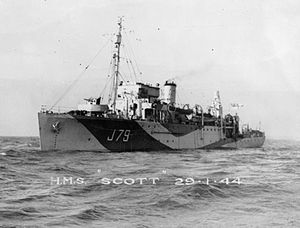HMS Scott (J79)

HMS Scott, 1944
|
|
| History | |
|---|---|
|
|
|
| Name: | HMS Scott |
| Namesake: | Robert Falcon Scott |
| Builder: | Caledon Shipbuilding & Engineering Company, Dundee |
| Laid down: | 30 August 1937 |
| Launched: | 23 August 1938 |
| Completed: | 23 February 1939 |
| Fate: | Scrapped, 1965 |
| General characteristics | |
| Class and type: | Halcyon-class minesweeper |
| Displacement: | |
| Length: | 245 ft 9 in (74.90 m) o/a |
| Beam: | 33 ft 6 in (10.21 m) |
| Draught: | 8 ft (2.4 m) |
| Propulsion: |
|
| Speed: | 17 knots (31 km/h; 20 mph) |
| Complement: | 80 |
HMS Scott (J79) was a Halcyon-class minesweeper (officially, "fleet minesweeping sloop") of the British Royal Navy completed as an unarmed survey ship with an enlarged bridge and a large chart room abaft the extended forecastle deck. She served through World War II and the two following decades.
Scott surveyed the English Channel in 1939 in preparation for laying a Channel Mine Barrage, and directed minelayers laying the barrage immediately following declaration of war. She was equipped for anti-submarine escort assignments when the Channel minelaying was completed, but retained the chart room by sacrificing her mainmast to compensate for the additional topside weight of a QF 12 pounder 12 cwt naval gun on the forecastle. By the spring of 1940 her assignments were refocused on minelaying surveys rather than escort work. She measured depth of water with tidal fluctuations and currents to determine suitable minefield locations.
In May 1941 Scott narrowly avoided detection by the German battleship Bismarck while surveying Greenland pack ice in the Denmark Strait. She was damaged in a collision with HMS Arethusa in December 1941 while assisting the British Commando raid Operation Anklet on the Lofoten Islands.
After the collision damage was repaired, Scott focused on providing navigational information for the minelayers placing the Northern Barrage between Greenland and Scotland from the spring of 1942 until the project was abandoned in the autumn of 1943. She surveyed the minefields in advance, and then accompanied the minelayers while the fields were placed.
...
Wikipedia
